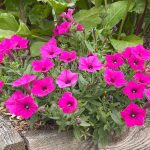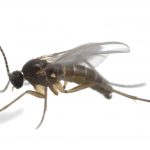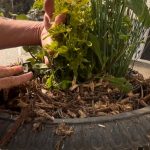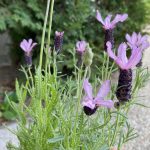When should you use Perlite vs Vermiculite?

Perlite and Vermiculite are soil additives that have been used in the horticultural industry for years. If you’re getting started with gardening, you’re likely wondering what the differences are with perlite vs vermiculite.
Derived from naturally formed minerals, Perlite and Vermiculite undergo a unique superheating process to achieve the distinct compositions we commonly recognize today. Perlite and Vermiculite are additives to soil that can help your plants flourish and ensure that your gardening efforts product a healthy bounty.
Though their names may bear some semblance, their respective roles are markedly distinct and almost opposite. While Vermiculite is added to soil to help with water and mineral retention, perlite is often used to assist in drainage. Both perlite and vermiculite have their important uses!
Let’s delve into the applications for perlite and vermiculate in the home garden.

Want the inside scoop on more gardening tips? Get early access to all my blogs and exclusive content by signing up for my newsletter!
What is Perlite?

Perlite is a lightweight, off-white-coloured porous mineral pellet composed of 88% air, which maintains its structure and composition when integrated into the soil.
The word Perlite comes from the Latin word ‘Perla,’ which means pearl, obviously referring to its rounded, pearly-looking appearance.
Perlite is formed by superheating and rapidly cooling volcanic rock or glass, which causes water to escape from its mineral silicon obsidian base, causing the rock to pop like popcorn and giving it its whitish appearance.
Perlite can hold air in external pockets on its pellet but never imbibes air into its internal structure. Because of this, Perlite can hold water for a short period, and then it rapidly releases it, making it so effective at soil aeration.
In addition to lightening soil structure, Perlite facilitates optimal drainage, fostering robust root development.
Perlite adds no nutrient value to soil and, with its relatively neutral pH range (7.0-7.5), can only marginally contribute to neutralizing the soil’s acidity levels.
Where to Use Perlite

Perlite is used in soils that need improved drainage or where plant roots tolerate moisture poorly.
For example, Perlite is a key element when amending soil to grow succulents.
Related: How to Care for Succulents: The Ultimate Guide
Succulents grow best in arid soil conditions, and to achieve well-draining soil, one can add up to a 30% volume of Perlite to potting soil and continue to adjust as necessary.
For regular potting soil scenarios, start with an added 10-15% Perlite volume if improved drainage is needed and add more, little by little, to achieve the right proportion for your plants. If you find that water is pooling when you water your plants, that is a good indicator you could use perlite to help your plants flourish.
What is Vermiculite?

Vermiculite is a lightweight material derived from weathered mica and chlorine deposits found in clay layers.
Vermiculite is a shiny, spongy, lightweight mineral with bronzy, light brown, and dark brown hues.
Vermiculite, like Perlite, is superheated so that its structure expands and splits into layers, called exfoliation.
Vermiculite possesses porous characteristics but champions water retention, contrary to Perlite, acting like a sponge, holding and releasing water into the soil as hydration rises and falls.
Vermiculite expands as it incorporates 3-4 times its weight in water, resembling small worms.
As a matter of fact, Vermiculite comes from the word ‘vermiculare’, which means ‘to breed worms’ in Latin.
Vermiculite exerts a minor influence on aeration compared to Perlite because it expands and contracts as water is absorbed or released.
Furthermore, Vermiculite contributes minimally to soil nutrient content, but its chemical structure enhances the soil’s ability to retain and distribute nutrients effectively.
With a rather broad pH range, spanning from 6.0 (acidic) to 9.0 (alkaline), it is advisable to opt for a neutral variant (7.0) of Vermiculite, which is primarily used in horticulture.

Want the inside scoop on more gardening tips? Get early access to all my blogs and exclusive content by signing up for my newsletter!
Where to Use Vermiculite


Vermiculite is most commonly used in potting soils to improve water retention capabilities, and it makes an excellent seed cover for either indoor or outdoor garden seeding, preventing seeds from drying out as long as it is hydrated.
If you feel that your soil needs a boost, add 10% Vermiculite by volume and see how that goes and feels when hydrated, and it is recommended to keep Vermiculite input at 30%.
Related: Gardening with Mulch
Can Perlite and Vermiculite be Used Together?

Yes! Because Perlite and Vermiculite have almost opposite functions, they can be used synergistically to cater to diverse plant requirements.
Sometimes, soil works best to have equal amounts of Perlite and Vermiculite; at other times, it may need twice the amount of either Perlite or Vermiculite.
Generally, most plants grow best in loose and well-draining soils, so exact mixing percentages often don’t matter. Growing difficulty lies more at the extreme ends of the spectrum, like if the soil is excessively wet or dry.
Perlite and Vermiculite are available in varying pellet sizes, such as small, medium, and large.
Related: 6 Ways to Care for Your Garden in Hot, Dry Weather
Perlite vs Vermiculite Gardening

Adding Perlite and Vermiculite to your garden tactics can help your plants grow healthy, avoid root rot, and ensure that they are getting the nourishment and water they need.
I hope these insights into the properties and characteristics of Perlite and Vermiculite are helpful as you cultivate and grow your garden this season!
Knowing the exact amount of Perlite vs Vermiculite to use in your garden varies on a wide number of factors. That’s why it’s so important to really look at what your plants are doing, what kind of care they need, and adjust on a garden to garden basis.
Sometimes you might need more Perlite, sometimes more Vermiculite, or you might even have soil that needs neither!
Be sure to pay attention to the signs your plants are giving you and adjust your garden additives as needed.
If you have questions about Perlite and Vermiculite, feel free to reach out or sign up for my newsletter for more tips!
©Sharon Wallish Murphy ©Gardening with Sharon






























